
Bird nests are intricate structures built by birds for shelter, laying eggs, and raising offspring. Their diversity in design reflects species-specific adaptations to environment and predators, showcasing remarkable engineering skills and resourcefulness in using available materials like twigs, mud, and feathers to ensure survival and reproductive success.
Overview of Bird Nesting Behavior
Bird nesting behavior varies widely among species, driven by the need for shelter, reproduction, and survival; Most birds build nests to lay eggs and raise their young, while others may reuse existing structures. Nesting strategies often align with breeding seasons, ensuring optimal conditions for offspring. Birds exhibit remarkable resourcefulness, using diverse materials like twigs, mud, and feathers. Nest placement is crucial, with some species favoring trees, others ground sites, and a few utilizing human-made structures. Parental involvement differs, ranging from shared responsibilities to sole care by one parent. This behavior underscores their adaptability and commitment to ensuring the survival of their offspring.
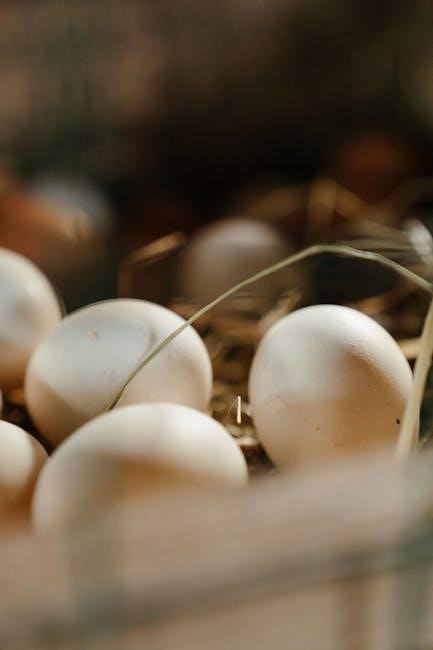
Importance of Studying Bird Nests
Studying bird nests provides valuable insights into avian ecology, behavior, and conservation. Nests reveal species-specific adaptations, such as material selection and structural design, which are crucial for survival. Understanding nesting behavior helps identify habitat needs, breeding patterns, and environmental impacts. This knowledge informs conservation efforts, aiding in protecting vulnerable species and ecosystems. Additionally, nest studies highlight the effects of human activities on bird populations, such as habitat loss and predation. By examining nests, researchers can develop strategies to mitigate these threats, ensuring the survival of bird species in diverse and changing environments.
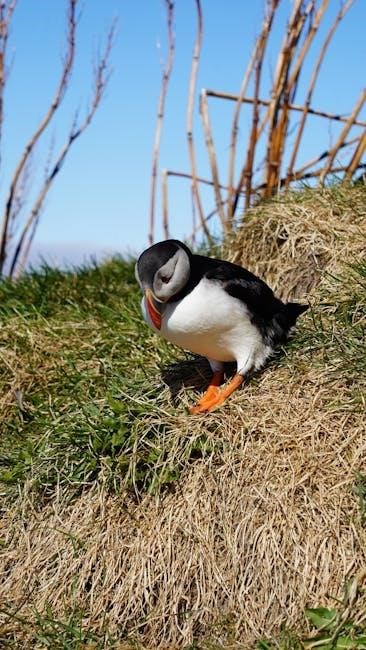
Types of Bird Nests
Bird nests vary widely, including cup, cavity, platform, pendant, and ground nests, each constructed with materials like twigs, mud, feathers, and plant fibers for survival.
Cup Nests
Cup nests are the most common type, built by birds like robins and songbirds; They are typically bowl-shaped, constructed from twigs, mud, and soft materials, often lined with feathers or plant fibers for comfort. These nests are usually placed in trees, shrubs, or man-made structures, providing protection from predators and harsh weather. The cup shape allows for effective egg incubation and chick rearing, with the structure designed to cradle eggs securely. Variations in size and material use exist among species, but the cup nest remains a universal symbol of bird nesting behavior, showcasing their engineering prowess and adaptability to diverse environments.
Cavity Nests
Cavity nests are built by birds that utilize pre-existing holes or excavate their own in trees, rock faces, or other structures. Species like woodpeckers, owls, and bluebirds often use these nests, which provide natural protection from predators and harsh weather. Some birds line the cavities with soft materials like feathers or moss for comfort. Cavity nests are typically simple in structure, relying on the existing enclosure for support. They are an essential adaptation for species that lack the ability or need to build elaborate nests, ensuring survival and reproductive success in diverse habitats, from forests to urban areas.
Platform Nests
Platform nests are large, flat structures built by birds like eagles, ospreys, and herons. These nests are typically constructed in trees, on cliffs, or even on man-made structures like power poles. Made from sturdy materials such as sticks, branches, and sometimes mud or seaweed, platform nests provide a stable base for laying eggs and raising chicks. They are often reused and added to each year, becoming increasingly robust; Some species also incorporate unusual items like plastic or fishing nets into their platforms. These nests are essential for species that require a solid foundation for their breeding activities, ensuring safety and stability in various environments.
Pendant Nests
Pendant nests are unique, hanging structures built by certain bird species, such as orioles and weavers. These nests are typically suspended from tree branches and constructed using flexible materials like grasses, spider webs, and plant fibers. The nests are often shaped like bags or sacs, providing excellent protection from predators and harsh weather. Some species intricately weave these nests, ensuring they are both durable and camouflaged. Pendant nests are remarkable examples of avian engineering, showcasing the creativity and adaptability of birds in their nesting behaviors. They are a key adaptation for survival in diverse habitats, offering safety and stability for eggs and chicks.
Ground Nests
Ground nests are constructed directly on the earth or in shallow depressions, often by species like plovers, ovenbirds, and grouse. These nests are typically camouflaged with surrounding materials such as grasses, leaves, and pebbles to avoid detection by predators. Some birds dig burrows or use existing ones to create hidden nesting sites. Ground nests are simple in structure but effective for species that require close contact with the terrain for foraging or escape. While they offer protection from aerial threats, they remain vulnerable to ground-based predators and human disturbances like agriculture or recreational activities. Their design emphasizes blending seamlessly into the environment.
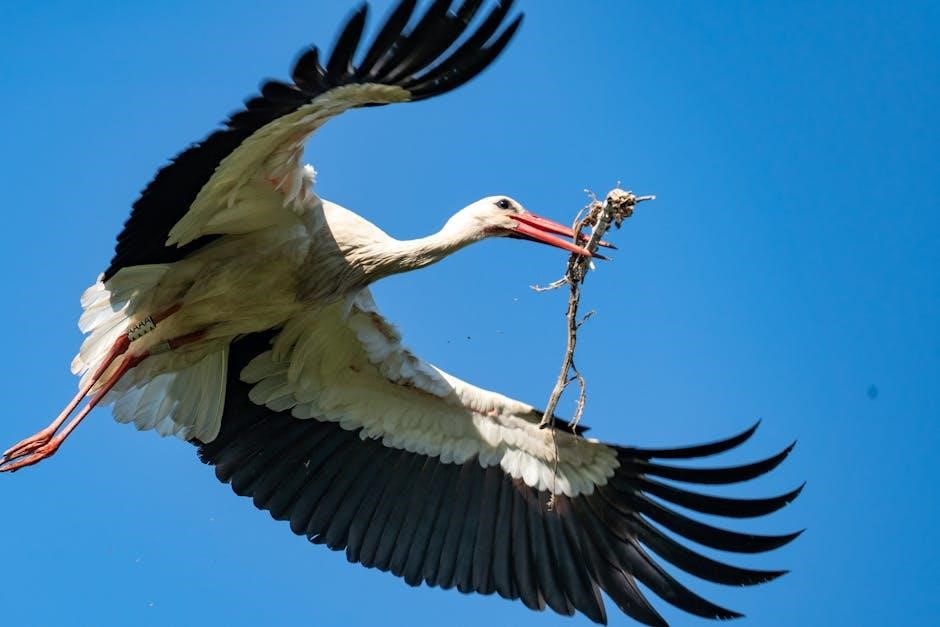
Materials Used in Nest Construction
Birds use diverse materials like twigs, mud, feathers, plant fibers, and spider webs to build nests, ensuring structural integrity and camouflage for survival and reproduction success.
Twigs and Branches
Twigs and branches are the most common materials used in nest construction, providing structural support and flexibility. Birds carefully select sturdy yet pliable twigs to form the nest’s base and framework. These materials are often arranged in layers, with smaller twigs woven together for stability. While twigs form the primary structure, they are frequently combined with other materials like mud or plant fibers to reinforce the nest. This combination ensures the nest is both durable and camouflaged, protecting it from predators and harsh weather conditions. The use of twigs reflects a bird’s resourcefulness in utilizing readily available natural resources for nesting success.
Feathers and Soft Materials
Feathers and soft materials like plant down, moss, and fur are commonly used to line bird nests, providing comfort and insulation. These materials help regulate nest temperature, ensuring eggs and chicks remain at optimal conditions. Feathers are often collected from the ground or plucked from the bird’s own body, while soft plant fibers are carefully selected for their flexibility and warmth. This lining not only enhances the nest’s comfort but also aids in camouflage, blending the nest with its surroundings to avoid detection by predators. The use of feathers and soft materials highlights a bird’s attention to detail in creating a safe and nurturing environment for its young.
Mud and Plant Fibers
Mud and plant fibers are essential materials for nest construction, offering durability and protection. Birds like swallows and pigeons use mud mixed with saliva to create strong, water-resistant nests. Plant fibers, such as grasses and reeds, are often woven together to form the nest’s structure, providing flexibility and strength. These materials are readily available and effective in creating nests that withstand environmental challenges. The combination of mud and plant fibers ensures nests are both sturdy and camouflaged, helping birds protect their young from predators and harsh weather conditions while blending seamlessly into their surroundings.
Spider Webs and Insect Silk
Spider webs and insect silk are unique materials used by some bird species to construct their nests. These sticky, flexible threads provide excellent structural support and help bind other materials together, creating a durable and elastic nest. Birds often incorporate spider webs to enhance the nest’s strength and stability, while insect silk adds softness and insulation. This combination of materials allows nests to withstand environmental stresses like wind and rain. Additionally, the use of spider webs and silk can help camouflage the nest, making it less visible to predators and improving the chances of survival for the eggs and chicks inside.
Nesting Locations
Birds choose diverse locations for nesting, including trees, cliffs, ground, and man-made structures. Each species selects sites based on habitat, predator avoidance, and accessibility to resources.
Trees and Shrubs
Trees and shrubs are among the most common nesting locations for birds, offering protection and accessibility; Many species, like robins and warblers, build cup-shaped nests in branches or forks, while others, such as woodpeckers, excavate cavities. Dense foliage provides camouflage, shielding nests from predators and harsh weather. Some birds, like Orioles, construct pendant nests, dangling from tree limbs, while others, such as herons, create platform nests in tree canopies. The diversity in nesting strategies within trees and shrubs highlights birds’ adaptability and resourcefulness in selecting safe and suitable locations for raising their young.
Cliffs and Rock Faces
Cliffs and rock faces provide unique nesting sites for certain bird species, offering natural protection from predators and harsh weather. Birds like seabirds, raptors, and some passerines often nest on ledges or within crevices. These locations allow for structural reinforcement, as nests are secured by the rock’s stability. Camouflage is enhanced by the surrounding environment, blending nests with the rugged backdrop. Some species, such as puffins, excavate burrows into cliff sides, while others, like eagles, build platform nests on narrow ledges. This adaptation ensures safety and accessibility, making cliffs a critical nesting habitat for many bird populations worldwide.
Ground and Burrows
Ground nests and burrows are strategic nesting locations for birds seeking protection and camouflage. Many species, such as grouse and plovers, build nests directly on the ground, often concealing them with vegetation. Others, like kingfishers and puffins, excavate burrows into cliffs or banks, creating hidden chambers. These nests are typically lined with soft materials like feathers or grasses for comfort and insulation. Burrowing birds benefit from reduced predator risk and stable temperatures, while ground-nesting birds rely on camouflage to avoid detection. Both strategies highlight adaptive nesting behaviors tailored to specific environmental challenges and survival needs.
Man-made Structures
Birds often utilize man-made structures for nesting, such as buildings, bridges, and eaves, offering shelter and protection from predators. Species like swallows and sparrows frequently nest in these areas, constructing nests from mud, twigs, and saliva. Barns, sheds, and urban infrastructure provide ideal spots for these birds, while nest boxes and birdhouses are specifically designed to attract cavity-nesting species. This adaptation reflects birds’ ability to thrive in human-altered environments, ensuring survival and reproductive success in diverse habitats. Man-made structures thus play a crucial role in supporting avian populations in both rural and urban settings.
Nest-Building Techniques
Birds employ diverse techniques to construct nests, such as weaving twigs, applying mud, and arranging plant fibers, ensuring structural stability and safety for their offspring.
Weaving and Knotting
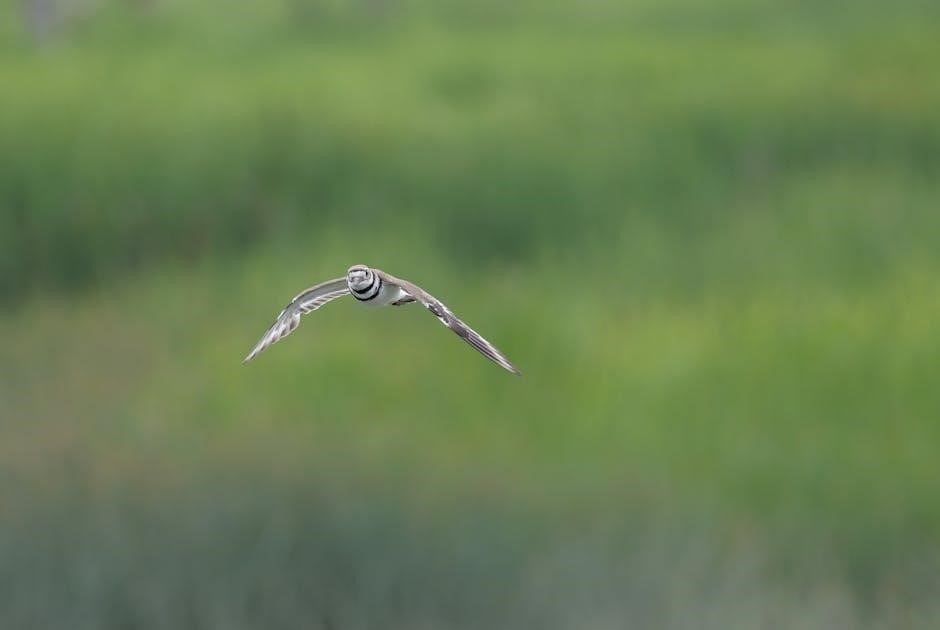
Weaving and knotting are essential techniques birds use to construct nests, ensuring durability and safety. By interlacing twigs, grasses, and other flexible materials, birds create sturdy cup-shaped nests. Some species reinforce their nests with mud or spider webs for added strength. This method allows birds to build intricate structures tailored to their needs, providing protection from predators and harsh weather. For example, robins and songbirds often use these techniques to craft nests that securely hold their eggs and chicks, showcasing their remarkable engineering skills and adaptability to environmental challenges.
Mud and Saliva Use
Mud and saliva are crucial materials for nest construction in many bird species. Birds like swallows and martins use mud to create strong, durable nests. They mix mud with saliva to form a pliable adhesive, which hardens upon drying. This technique allows them to build nests on vertical surfaces, such as cliffs or buildings, ensuring stability. The use of mud and saliva not only provides structural integrity but also protects the nest from environmental factors. This unique method highlights birds’ resourcefulness and adaptability in using readily available materials to safeguard their offspring, ensuring successful reproduction and survival.
Plant Fiber Arrangement
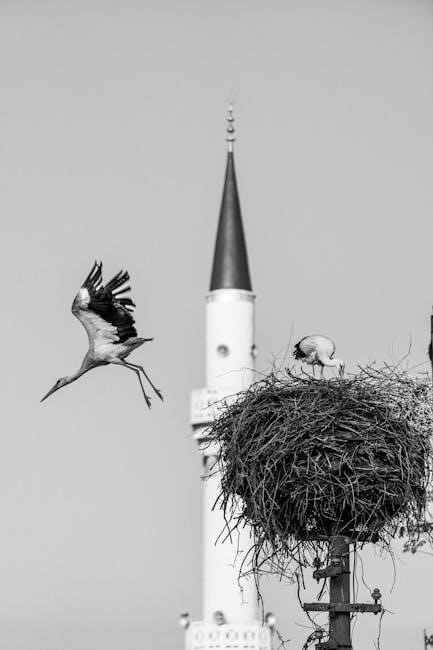
Plant fibers are a primary material in nest construction, arranged meticulously to create a sturdy yet flexible structure. Birds like weavers and orioles excel in this technique, weaving grasses and plant strips into intricate patterns. The arrangement ensures the nest’s shape is maintained while providing insulation and protection. This method also allows for natural camouflage, blending the nest with its surroundings. The precision in arranging plant fibers demonstrates birds’ remarkable engineering skills, ensuring a safe and stable environment for their eggs and chicks, while also safeguarding against environmental challenges and predators. This technique is vital for the survival and success of many bird species.
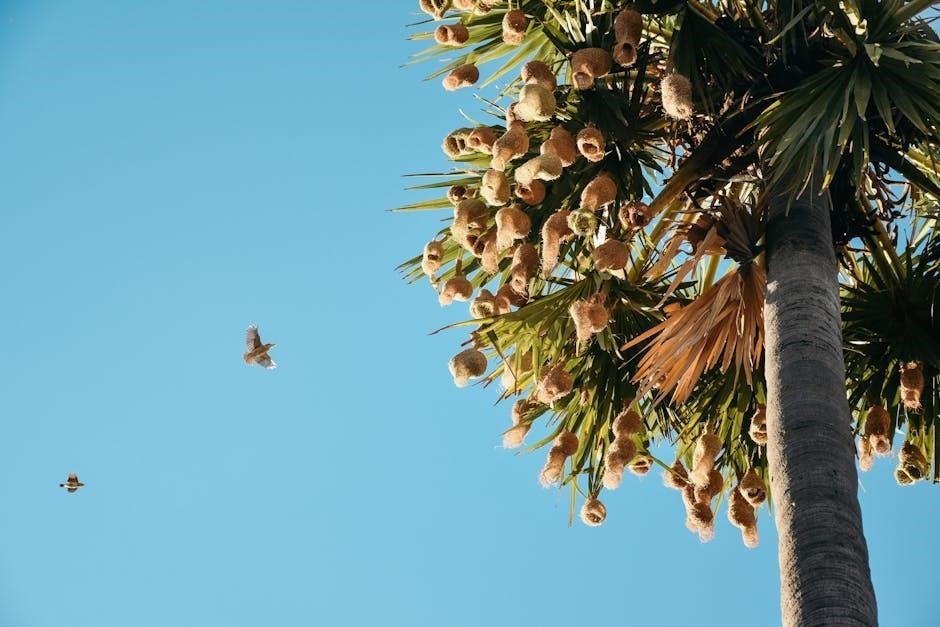
Adaptations for Survival
Bird nests exhibit remarkable adaptations to ensure survival, such as structural reinforcement and thermal insulation, enabling birds to withstand environmental challenges and protect their young effectively.
Camouflage and Concealment
Bird nests often feature camouflage to blend seamlessly into their surroundings, reducing detection by predators. Birds use materials like twigs, leaves, and mud to create nests that mimic their environment. For example, nests built in tree branches may resemble natural knots or foliage, while ground nests can look like piles of debris. This concealment strategy is crucial for survival, as it protects eggs and chicks from predators. Some species even incorporate spider webs or insect silk to strengthen the nest’s disguise. Effective camouflage ensures the nest remains undetected, increasing the likelihood of successful reproduction and survival.
Structural Reinforcement
Bird nests are reinforced with strong, durable materials to withstand environmental challenges. Twigs, branches, and plant fibers form the framework, while mud and saliva act as adhesives to bind components together. Some birds, like swallows, use mud mixed with saliva to create hardened nest walls. Weaving and knotting techniques enhance structural integrity, ensuring the nest can support the weight of eggs and chicks. Platform nests, such as those built by eagles, use layers of sturdy materials for stability. These reinforcements protect nests from wind, rain, and predators, ensuring a safe environment for incubation and chick-rearing.
Thermal Insulation
Bird nests often incorporate materials that provide thermal insulation, helping to regulate temperature for eggs and chicks. Feathers, soft plant fibers, and moss are commonly used to line nests, creating a warm, protective environment. These materials reduce heat loss, especially in colder climates, ensuring optimal conditions for incubation. Additionally, the structure of the nest itself, with layers of denser materials like twigs and mud, helps insulate against extreme temperatures. This adaptation is crucial for maintaining stable nest temperatures, promoting successful hatching and chick development, and enhancing overall reproductive success for bird species.
Conservation and Human Impact
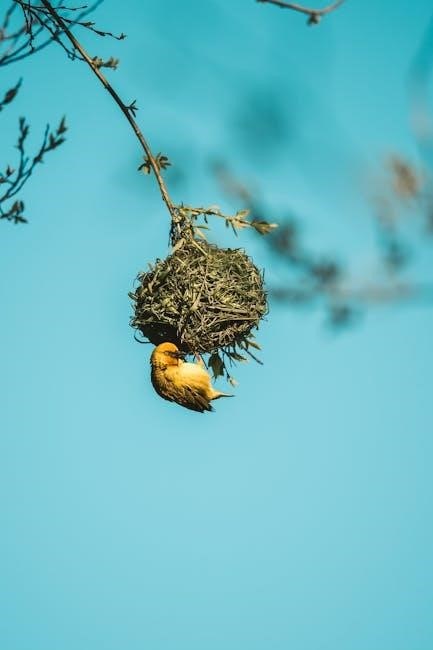
Habitat destruction and human disturbances threaten bird nests, disrupting breeding success. Conservation efforts, including nest boxes and protected areas, help mitigate these impacts, supporting bird populations.
Effects of Habitat Loss
Habitat loss significantly impacts bird nesting by reducing available nesting sites and materials. Deforestation, urbanization, and agriculture destroy natural habitats, forcing birds to adapt or face population decline. Fragmented landscapes isolate bird populations, making it harder for them to find mates or resources. This disruption increases nest predation and competition, stressing bird populations. Human activities like logging and land conversion exacerbate these issues, threatening species that rely on specific habitats. Conservation efforts, such as habitat restoration and corridor creation, are essential to mitigate these effects and protect bird diversity.
Nest Predation and Disturbance
Nest predation is a major threat to bird reproductive success, with predators targeting eggs and chicks. Human activities, such as recreational pursuits, can disturb nesting sites, causing birds to abandon their nests. Even brief disturbances can stress birds, reducing their ability to care for their young. Predators, like snakes and raccoons, are attracted to nests, especially in fragmented habitats. Human proximity to nests often leads to increased predation risk, as predators are drawn to the activity. Protecting nests from disturbance and predation is crucial for maintaining healthy bird populations and ensuring successful breeding cycles.

Role of Nest Boxes and Birdhouses
Nest boxes and birdhouses play a vital role in supporting bird populations by providing cavity-nesting species with safe breeding habitats. These structures are especially beneficial in urban and fragmented landscapes where natural nesting sites are scarce. By installing nest boxes, individuals can attract specific bird species, such as bluebirds or swallows, and contribute to their conservation. Proper installation, including placement and maintenance, ensures the effectiveness of these nests. Nest boxes also serve as valuable tools for research and education, helping to monitor bird behavior and promote environmental awareness. They are a simple yet impactful way to support bird ecology.

Interesting Facts and Myths
A common myth is that bird nests are solely made of twigs, but they often incorporate feathers, mud, and even spider webs for added strength and insulation.
Common Misconceptions About Bird Nests
Many believe bird nests are only made of twigs, but materials like feathers, mud, and spider webs are also used. Another myth is that disturbing a nest will always scare the mother away, though some birds are more tolerant. Additionally, not all birds nest in trees; many ground-dwelling species nest on or below the ground. Some think nest boxes attract all bird species, but only cavity-nesting birds use them. These misconceptions highlight the diversity and complexity of bird nesting behaviors, often overlooked by casual observers.
Birds That Do Not Build Nests
Some bird species do not construct nests, relying instead on alternative methods for reproduction. Certain birds, like brood parasitic species such as cuckoos, lay their eggs in other birds’ nests, leaving the host to care for their young. Others, such as Emperor Penguins, balance eggs on their feet rather than building nests. Additionally, some bird species may use existing cavities or platforms, avoiding nest construction altogether. These unique reproductive strategies highlight the diverse adaptations among birds, emphasizing that nesting behaviors vary widely across different species.
Unique Nesting Behaviors
Birds exhibit fascinating nesting behaviors that highlight their adaptability and ingenuity. Some species, like weaverbirds, construct elaborate nests with intricate weaving patterns, while others, such as orioles, suspend pouch-like nests from tree branches. Certain birds line their nests with feathers or soft materials for added comfort, while others, like swallows, use mud and saliva to create durable structures. These unique strategies not only provide protection but also reflect the evolutionary pressures shaping avian nesting behaviors. Such diversity underscores the remarkable creativity birds employ to ensure survival and reproductive success in varied environments.
Bird nests are incredible examples of nature’s engineering, showcasing diversity in design, materials, and purpose. They play a crucial role in bird survival and reproductive success, adapting to various environments to ensure offspring protection and growth.
Bird nests exhibit remarkable diversity, ranging from simple ground nests to intricate cup, cavity, platform, and pendant nests. Each type reflects unique adaptations to environments and predator threats. Materials vary widely, including twigs, mud, feathers, and even spider webs, showcasing birds’ resourcefulness. Nest locations span trees, cliffs, burrows, and man-made structures, highlighting their ability to utilize available spaces. Some species, like weavers, create elaborate structures, while others, such as penguins, use simple scrapes. This diversity underscores the importance of nests in ensuring survival and reproductive success, making them a fascinating aspect of bird ecology and behavior.
Importance of Nesting in Bird Ecology
Nesting is a critical aspect of bird ecology, essential for reproduction and survival. Bird nests provide shelter from predators, protect eggs from environmental stress, and serve as a safe space for chicks to develop. Successful nesting ensures species survival by maintaining population stability. Additionally, nests play a role in ecosystem balance, as they often support other organisms like insects or fungi. The diversity of nesting behaviors highlights birds’ adaptability, while challenges like habitat loss and predation underscore the need for conservation efforts to protect these vital ecological structures and the species that depend on them.